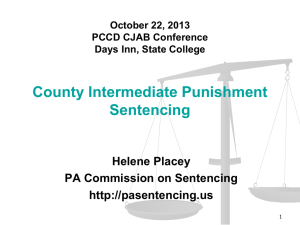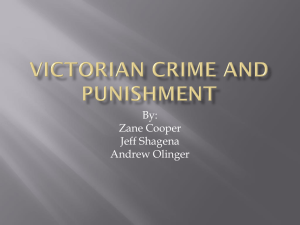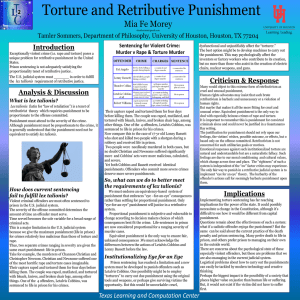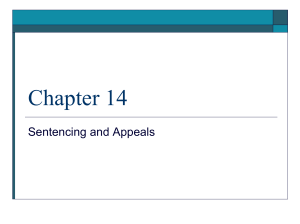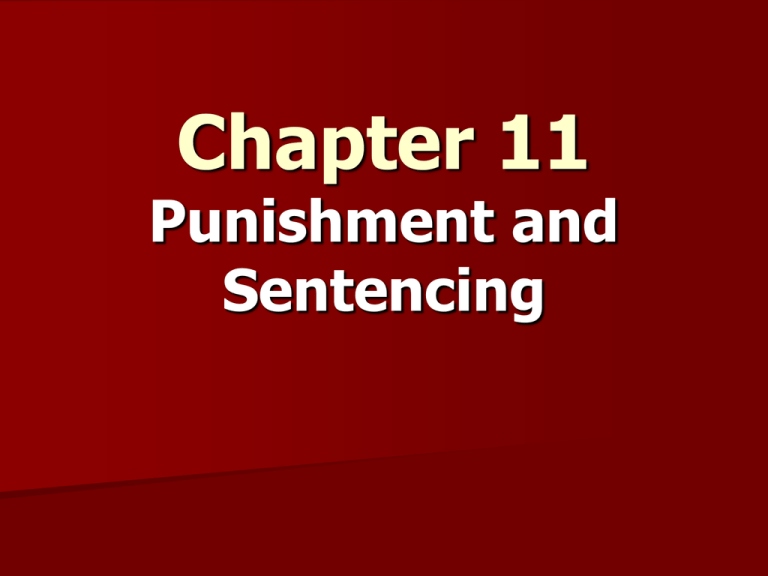
Chapter 11
Punishment and
Sentencing
Punishment Options Through
Time
Options now and in the past – people have been
quite inventive
– Death: done in all kinds of manners
– Physical pain: amputation, flogging, branding
– Loss of resources: fine, restitution, community service,
privileges (gun ownership, legal rights – civil death)
– Loss/restriction of liberty: jail, prison, probation, parole
– Shame and ostracism: dunking, stocks, scarlet letter,
sex offender registration, chain gangs
– Intermediary punishments: electronic, halfway houses,
boot camps, drug courts
Punishment Trends
From punishing the body to punishing the
mind
From physical pain to financial pain
The standard of proportionality – make
punishment fit the crime
The rise of the prison
The decline of public punishment
The Current Punishment Ladder
Ranging from restorative justice to the death penalty
Restorative justice
Fines and day fines
Probation (about 4 million in 2006)
– Treatment and control
– Conditions and Revocation
– Intensive Probation - ISP
Intermediary sentences (between release in liberty and
imprisonment)
– Drug courts; community service; house arrest, electronic monitoring;
restitution and forfeiture; “halfway houses”; boot camps
Imprisonment: jail and prison (over 2 million in 2006)
Death
Goals of Sentencing
– Deterrence: general and specific
– Incapacitation: general and selective (career
criminal)
– Punishment: retributive justice, just deserts
– Rehabilitation
– Restitution
– Reintegration
Goals of Sentencing
The Goals of Modern Sentencing
General Deterrence
– Punishing the offender serves to convince society, or
potential criminals, not to commit crimes
– Difficulty in determining the right amount of
punishment
– Some believe recent declines in crime rates are result
of tough sentences
– Assumes people consider consequences before acting
Specific Deterrence
– Will deter that particular offender from committing
future crimes
The Goals of Modern Sentencing
(cont.)
Incapacitation
– Confinement so that offender cannot commit more
crimes; keeps society safer; prevents future crimes
– General: all who sit in prison cannot commit crimes,
except against other people in the prison (guards,
staff, fellow prisoners)
– Specific: target repeat offenders or career criminals
who commits many offenses; locking them up is a
cost effective way of preventing many crimes
The estimates of how many crimes are prevented by each
incapacitation vary wildly
Goals of Sentencing (cont.)
Punishment/Retribution/Just Desert
– Those who commit crimes deserve to be
punished
– “A just measure of pain” proportional to the
harm done by the crime is the proper
sentence
– The sentence should be clear and certain (not
open-ended)
The Goals of Modern Sentencing
(cont.)
Rehabilitation
– Based on treatment philosophy that offenders
can be reformed
– Sometime called the medical model – crime is
an illness which can be cured with proper
treatment
– Requires that treatment services are available
for convicted offenders while in prison or
under state control
Goals of Modern Punishment
(cont.)
Equity/restitution
– It is fair and just for criminals to repay society
and their victims
– The concern is for the victim – the harm done
them should be made good
– Works better for property crimes, since the
harm done can be calculated, but less so for
person crime (e.g., what is the proper
restitution for sexual assault?)
Goals of Modern Punishment
(cont.)
Reintegration
– Almost all convicted offenders sentenced to prison will
return to society at some time
– A non-reintegrated offender is likely to commit
another crime, hence is a threat to others
– E.g., long prison sentences practically guarantee that the exconvict will re-offend, will not become a law abiding citizen
– Sentences should not make it impossible for exconvicts to be reintegrated into society
– Consider alternative sentences which are less likely to
complicate or undermine reintegration
Imposing the Sentence
Except for mandatory sentences, judges rely on
a variety of information
– Sentencing guidelines
– Victim impact statements
– Pre-sentence investigation reports
Concurrent sentences: person serves sentences
for two or more crimes at the same time
Consecutive sentences: sentences for two or
more criminal acts that are served one after the
other
Effects of good time can shorten sentences
Sentencing Models
Indeterminate sentences
– Based on a treatment philosophy which must
fit the needs of the offender
– Sentence has a minimum and maximum
– Inmate can earn time off for good behavior
– Early release but continued supervision
– Your prison sentence is completed when a
parole board decides you are safe to return to
society
Sentencing Models (cont.)
Determinate sentences
– Sometimes referred to as structured
sentences
– Prompted by dissatisfaction with disparity and
uncertainty of indeterminate sentencing.
– Defendants serve specified number of years
Truth in sentencing laws – sentences, or
percentage of, imposed by judge must be served
– Use of sentencing guidelines
Why Sentencing Guidelines
Limit judicial discretion, ensure greater
consistency, less disparity in sentencing
Constructing Guidelines: Who makes these
– Consultants, appointed commissions, legislatures
Constructing the sentencing table
– Two Underlying principles: Proportionality and
Criminal History
proportionality: the severity of punishment should be
proportional to the seriousness of the crime
criminal history: the severity of punishment should
increase for repeat offenses
Sentencing Guidelines
Constructing the Sentencing Table (cont.)
– Two decisions: Horizontal equity and vertical equity
– Vertical equity: Which crimes are more or less serious
than other crimes?
How much greater should the punishment be as go up vertical
equity?
– Horizontal equity: which crimes are similar in
seriousness to other crimes
Presumptive sentence: midpoint and ranges
Going outside the range: allowed or not;
mitigating and aggravating circumstances
Sentencing Models (cont.)
Effectiveness of guidelines
– They are too rigid, harsh and overly complex
– Take into account juvenile convictions
– Result in longer prison terms
– U.S. v. Booker held federal guidelines were
unconstitutional
they are advisory, not mandatory
The impact of sentencing guidelines on plea
bargaining
The Justice of Sentencing
Guidelines
Are guidelines fair?
– Limit the capacity of judges to tailor
punishment to the nature of the offense and
the offender
– Biased against African-Americans and other
minorities – criminal histories which affect
sentences may reflect prior discrimination
Sentencing Models (cont.)
Mandatory Sentences
– Bars judicial discretion
– May exclude probation
– May exclude parole
– May use minimum or maximum terms but most
commonly requires a fixed prison sentence
– Have been one factor contributing to the
increased the size of the correctional population
to record levels
Sentencing Models (cont.)
Three-strikes laws
– Provides lengthy prison terms for anyone
convicted of three felonies – many of the
statutes impose a life sentence
– May involve relatively trivial felony offenses
– Experts argue whether it has any deterrent
effect
– Can a prior guilty plea (after plea bargaining
or an Alford plea) be reversed if it leads to
third strike?
Sentencing Models (cont.)
Truth in sentencing
– Require offenders to serve a substantial
portion of their prison sentence behind bars
– Parole eligibility and good-time credits are
restricted or eliminated
How People are Sentenced
In 2002 more than 1 million adults were
convicted of a felonies in a single year.
About 2/3 of felons convicted in state
court were sentenced to a period of
confinement.
The average sentence in state courts was
4½ years.
Offenders generally served only 51
percent of their sentence.
Sentencing Patterns
Sentences tend to be quite severe
For example, the average prison sentence for violent offenders is 92
months=seven years and eight months, or about the time for two college
BAs
How People are Sentenced
(cont.)
Factors that effect sentencing:
– Seriousness of the crime
– Offender’s prior record
– Whether offender used violence
– Whether offender used a weapon
– Whether the crime was committed for money
How People are Sentenced
(cont.)
Factors That Effect Sentencing (cont.):
– Social class – lower class members may expect
to get longer sentence
– Gender – chivalry hypothesis; women receive
more favorable outcomes
– Age – more lenient with elderly offenders
– Victims with “negative personal characteristics”
– defendants may receive shorter sentences
– Racial status – minorities receive longer
sentences in some jurisdictions
Death Penalty
The most serious and irreversible punishment
Arguments for and against: can think about the D-P at
five levels
– Personal – could I personally kill someone?
– Philosophical – is it just to kill someone (adults, non-adults,
mentally disabled)?
– Effectiveness – does the death penalty deter others and save
lives?
– Can it be implemented as a policy in the correct way?
Is it discriminatory when applied?
Is it accurate – do innocent people get sentenced and executed?
Is the process done fairly – proper defense?
– Can we afford it financially: trials and appeals?
Death Penalty (cont.)
The death penalty is the outcome of a process; it is not
a philosophical issue in practice.
Prosecutors have to charge “death eligible” – using
aggravating circumstances
There are two trials:
– Guilty or not guilty trial
– Sentencing trial: a jury, not a judges, has to decide whether to
impose the death penalty after a guilty verdict; jury must be
“death qualified”
Automatic appeals on every death penalty conviction
Offenders sentenced to death row tend to spend many
years there, before execution, dying of natural causes,
violence by other inmates, or being set free
Capital Punishment
More than 14,500 executions since 1608
Supreme Court has limited crimes for
which death penalty may be imposed
Practically all executions are for
aggravated murder
Death penalty for murder is used in 38
states and by the federal government
Capital Punishment (cont.)
Approximately 3,400 people are currently under
sentence of death
Between 75 and 100 people are executed each year
In 2004, 59 people were executed
Lethal injection primary mode of execution;
– earlier methods, hanging, electric chair, gas chamber, shooting
are rarely used or allowed
Lethal injection, done out of sight, is considered the
most civilized form of killing a convict
– Lethal injection currently challenged as cruel and unusual
punishment
Unease over potential for error has caused decline in
number of inmates on death row and executions
Capital Punishment (cont.)
Arguments for the death penalty
– Incapacitation: when you are dead you cannot kill
again
– Deterrence: other murders will be prevented
– Morally correct: retributive justice
– Proportional to the crime: you kill, we kill you
– Reflects public opinion: public supports the death
penalty; support declines to about 50 percent if
people are told that life in prison without parole is an
alternative
– Unlikely chance of error: the system works
Capital Punishment (cont.)
Arguments against the death penalty
–
–
–
–
–
–
–
–
–
Possibility of error
Unfair use of discretion
Misplaced vengeance
Weak public support
Little deterrent effect – causes more crime than it
deters
Always a hope of rehabilitation
Racial, gender, and other bias
Brutalization effect
Expensive and morally wrong
Capital Punishment (cont.)
Legal Issues
– Furman v. Georgia: Discretionary imposition is
unconstitutional
– Gregg v. Georgia: Must consider aggravating
and mitigating circumstances
– Ring v. Arizona: Jury must impose sentence –
not judges
– Atkins v. Virginia: May not execute mentally ill
– Roper v. Simmons: Must be 18 years old to be
sentenced to death
Deterrence and Capital
Punishment
Deterrent effect of capital punishment
– Three methods of research used to try to
determine if death penalty deters crime
Immediate-impact studies
Time-series analysis
Contiguous-state analysis
– Most researchers have failed to show any
deterrent effect of capital punishment
– General consensus by researchers is that capital
punishment has little or no deterrent effect
How Does Deterrence Work?
Affects motivation
Seeks changes in future behavior
By changing the calculus of consequences
More effective if: certain, swift, and severe
Certainty and celerity seem to matter more than
severity
Depends on how much likely offenders know about
certainty, celerity, and severity
How Does Deterrence Work?
(cont.)
Deterrence works for some behaviors and
individuals but not others
– Traffic: works by personal experience
Why work in traffic: immediacy (celerity) and low costs for
behavior change (slow down when see police car)
– Murder and the death penalty
Many homicides are committed for emotion and passion –
little calculation
Some are committed for pay, not affected by possible
consequences
Difficult to calculate consequences: costs and benefits
Miscalculations of certainty (won’t get caught)
Long delays between sentence and execution
Deterrence
Deterrence as policy:
– Who can or needs to be deterred?
– targeting deterrence
% no need – won’t commit murder
% could be deterred by consequences
% cannot be deterred by consequences
But percentages for each group are unknown
– Most deterrence policies will change severity; easier
than changing celerity or certainty
The likelihood to over-deter
Severity will target the least able to be deterred
Inefficient use of resources – less severity could deter a lot
of people
The Deterrence Curve
Every person has a deterrence curve: the level of
punishment which would deter her/him from committing
a crime
For most people, it will take more punishment to deter
them from more serious crime and less punishment to
deter from non-serious crime
For some people, even little potential punishment will
deter them from all crimes
For other people, even severe potential punishment will
not deter them from most crime
The relationship between severity of punishment and
deterrence can be plotted on a deterrence curve
False Convictions
Over 120 death row inmates released since
1976, for having been falsely convicted – they
were innocent of the crime for which they
were sentenced to death
It is pretty certain that innocent people have
been executed
Race/ethnic composition of prisoners released
through DNA evidence (not all from death row)
– 183 total: 106 Black, 47 White, 18 Latino, 1 Asian
American, rest unknown (2003)
Death Penalty (cont.)
Reasons for false convictions
– Mistaken eyewitness identification
– Inaccurate forensics
– False confessions
– Jail house informants
– Bad defense lawyers
– Misconduct by prosecutors and police
Discrimination
Does race, gender, minority status affect who is
sentenced to death and who is executed?
– About 53 percent of executed in the US since 1976 have been
African-Americans
There is limited support that race of the offender by
itself (most studies look as black-white differences in
sentencing) is a factor
There may be a cumulative discriminatory effect, in
that at each stage of the process small
discriminatory decisions add up
– The proportion of Black death row inmates (about 47 percent) is
much larger than the proportion of black males in the general
population (Practically all death row inmates are male).
Discrimination
There is pretty clear evidence that the
race of offender and victim taken together
matter.
– White offenders who kill black victims are
much less likely to be charged, convicted, and
sentenced to death than are black offenders
who kill white victims
Fair Process
Most accused of a capital offense are poor and
cannot afford a lawyers
Many states provide little money for lawyers who
defend those on trial for a capital offense
There are many examples of lawyers doing very
little to protect the rights of their clients in capital
cases (sleeping while the trial goes on, failing to
cross examine witnesses, not objecting to rulings
when they should have)
The quality of defending varies from abysmal to
excellent

